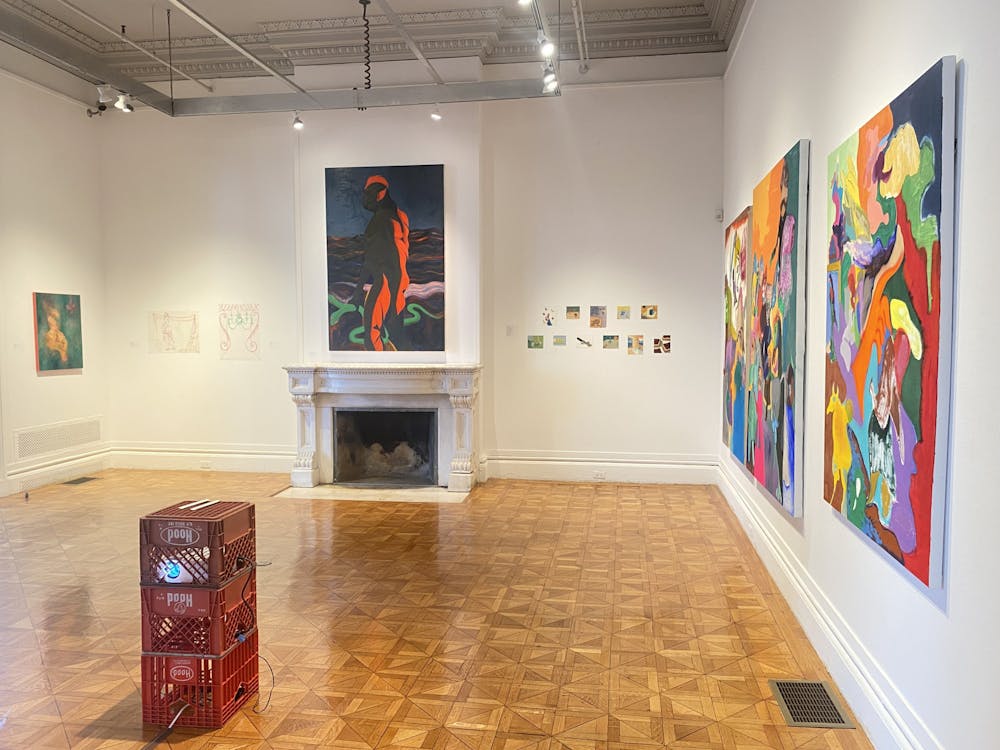Every three years, the Rhode Island School of Design’s Painting Triennial highlights graduate student artwork and diverse approaches to painting. Installed at RISD’s Woods-Gerry Gallery, this year’s show opened Sept. 30 and will remain until Oct. 16.
For RISD Graduate Program Director Jackie Gendel, the show provides a “sense of diversity of the kind of students we have.” Every student’s work on display was unique to their style and addressed different concerns, she added. Gendel said she considers the RISD painting department to be a “big tent” of ideas and approaches to painting.
The department cultivates a studio environment of “sustained curiosity” where students can create artwork stemming from their own questions, she added.
Scott Vander Veen, whose work was displayed in the show, said his creative process “starts with an interest in a material,” and his work reflects his exploration of “things that are used and touched by humans.” He added that painting as a form encapsulates all his different interests and processes.
Artists took varied approaches to their work, using materials like Mardi Gras beads and chewing gum and complementing paint with performance and multimedia video installations.
James Ming Johnson was also featured in the exhibition. His paintings are inspired by things he sees in real life, movies or historical photographs. In his work in the exhibition, Johnson also attempted to create an atmosphere similar to film scenes, he said.
“Nothing I make ever looks exactly like I intended, but I have to curate those choices,” he said. “Which parts do I rework? Which parts do I let be?"
Attendee Laura Case ’20 was drawn to the “western themes” in Johnson’s artwork. Johnson’s work is embedded with imagery and cultural references from southern California, where he grew up, he said.
Vander Veen’s pieces “Green Man #1” and “Untitled” use unconventional surfaces such as upholstery to thematically explore “the boundary between a person and an object,” a central focus of his work, he said.
“The content of my work really has to do with things about human relationships to objects, and how we move through the world,” Vander Veen said. “How we make up our persona has so much to do with this sort of porous boundary of what we think of as ourselves and then things outside of ourselves.”
The paintings displayed in the exhibition summarize Vander Veen’s creative interests and have “something fresh to me that I was excited about,” he said. The show allows artists the opportunity “to be vulnerable and take things out of their studio and share it,” he added.
Reflecting on the significance of the show for the Providence community, Johnson discussed the importance of “seeing artists at the beginning of their careers” because of how much their work evolves over their lives. Having this reference point is helpful, Johnson said. “I think about all the artists I look at who are in mid-career and I wish I could see their early works,” he explained.
Given that the show coincides with the start of the semester, there were limited choices for first-year graduate students to feature, according to G. Gendel said that almost everything in the show “is stuff that was made in the past few weeks since they’ve arrived.”
Gendel described the show’s curation as a “conversation” between students and faculty. She emphasized that support is one of “the most important things that you can have to actually set you up to be an artist.”
Viraj Mithani, another artist on display, considers the exhibition to be “an incredible opportunity for the larger community to come and access cultures from various parts of the world under one roof,” he wrote in an email to The Herald. “There are so many varying sensibilities and backgrounds that come together to form a cohesive arrangement which is truly exciting and also challenging in an educative way.”





